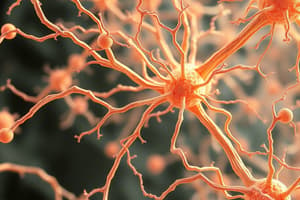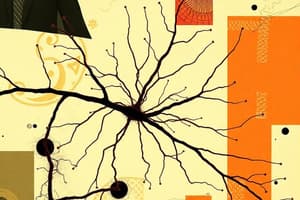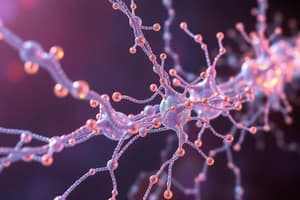Podcast
Questions and Answers
Which of the following best describes what 'n' represents in the equation for elongation rate of cytoskeletal filaments?
Which of the following best describes what 'n' represents in the equation for elongation rate of cytoskeletal filaments?
- The total number of free subunits in the solution.
- The relative viscosity of the solution.
- The rate constant for subunit dissociation.
- The number of subunits incorporated into (or dissociating from) the filament. (correct)
Actin polymerization always proceeds linearly from the start, without an initial lag phase.
Actin polymerization always proceeds linearly from the start, without an initial lag phase.
False (B)
What is the effect of adding actin oligomers on the actin polymerization growth curve?
What is the effect of adding actin oligomers on the actin polymerization growth curve?
eliminates the lag phase
The elongation rate of a cytoskeletal filament is determined by the balance between subunit ______ and dissociation.
The elongation rate of a cytoskeletal filament is determined by the balance between subunit ______ and dissociation.
Match the factor with its effect on polymerization.
Match the factor with its effect on polymerization.
Which of the following best describes the impact of technological advancements on the discovery of microtubules?
Which of the following best describes the impact of technological advancements on the discovery of microtubules?
Colchicine has only been used in modern medicine after the discovery of microtubules.
Colchicine has only been used in modern medicine after the discovery of microtubules.
Who is credited with advancements to Zellsubstanz, Kern und Zelltheilung (1882)?
Who is credited with advancements to Zellsubstanz, Kern und Zelltheilung (1882)?
The identification of the _____ binding protein, tubulin, occurred in 1967.
The identification of the _____ binding protein, tubulin, occurred in 1967.
Match the scientist with their contribution to cell biology:
Match the scientist with their contribution to cell biology:
Based on the timeline provided, what can be inferred about the relationship between the discovery of the cell nucleus, cell division, and microtubules?
Based on the timeline provided, what can be inferred about the relationship between the discovery of the cell nucleus, cell division, and microtubules?
What was the primary motivation for using colchicine in ancient Egypt?
What was the primary motivation for using colchicine in ancient Egypt?
What is the state of microtubule dynamics when the concentration of free subunits equals the critical concentration (Cc)?
What is the state of microtubule dynamics when the concentration of free subunits equals the critical concentration (Cc)?
Microtubule dynamics in vitro are unpredictable even when the critical concentration (Cc) is known.
Microtubule dynamics in vitro are unpredictable even when the critical concentration (Cc) is known.
What is effectively measured through the biochemical analysis of cytoskeletons?
What is effectively measured through the biochemical analysis of cytoskeletons?
When the concentration of free subunits is __________ Cc, polymers will grow.
When the concentration of free subunits is __________ Cc, polymers will grow.
Match each phase of filament assembly with its description:
Match each phase of filament assembly with its description:
What unexpected observation was made regarding individual microtubules through visualization by microscopy?
What unexpected observation was made regarding individual microtubules through visualization by microscopy?
If the concentration of free subunits is less than Cc.
If the concentration of free subunits is less than Cc.
Filament mass is directly proportional to both the number and length of the filaments.
Filament mass is directly proportional to both the number and length of the filaments.
What concentration is essential for predicting microtubule dynamics in vitro?
What concentration is essential for predicting microtubule dynamics in vitro?
According to Mitchison and Kirschner's 1984 theory, what primarily determines whether a microtubule (MT) keeps growing?
According to Mitchison and Kirschner's 1984 theory, what primarily determines whether a microtubule (MT) keeps growing?
In Condition 1, where there is a net increase in mass, the frequencies of microtubules remain constant over time.
In Condition 1, where there is a net increase in mass, the frequencies of microtubules remain constant over time.
What is the key distinction in microtubule behavior when comparing instances where free tubulin concentration is less than the critical concentration (Cc) versus when it is greater?
What is the key distinction in microtubule behavior when comparing instances where free tubulin concentration is less than the critical concentration (Cc) versus when it is greater?
Mitchison and Kirschner's ground-breaking theory, proposed in 1984, addressed the dynamics of what cellular structure? Answer: _______.
Mitchison and Kirschner's ground-breaking theory, proposed in 1984, addressed the dynamics of what cellular structure? Answer: _______.
Match each condition with its corresponding effect on microtubule mass:
Match each condition with its corresponding effect on microtubule mass:
In the context of microtubule dynamics, what does the term 'dynamic instability' refer to?
In the context of microtubule dynamics, what does the term 'dynamic instability' refer to?
Based on the information about microtubule frequencies, after dilution, the frequencies of microtubules will be the same in condition 1 and condition 2.
Based on the information about microtubule frequencies, after dilution, the frequencies of microtubules will be the same in condition 1 and condition 2.
What biochemical theories are consistent with both a net increase and net decrease in mass regarding microtubule behavior?
What biochemical theories are consistent with both a net increase and net decrease in mass regarding microtubule behavior?
Briefly explain the significance of Mitchison and Kirschner's observation that some microtubules continue to grow even when the free tubulin concentration is less than the critical concentration (Cc).
Briefly explain the significance of Mitchison and Kirschner's observation that some microtubules continue to grow even when the free tubulin concentration is less than the critical concentration (Cc).
Flashcards
Cytoskeleton
Cytoskeleton
Structural proteins in cells, composed of F-actin and microtubules.
Elongation Rate
Elongation Rate
The rate at which subunits are added to and removed from a filament.
Rate Constant
Rate Constant
The binding constant and dissociation represent the constant rate of binding and unbinding of the monomer, respectively.
Incorporation
Incorporation
Signup and view all the flashcards
Dissociation
Dissociation
Signup and view all the flashcards
Colchicine
Colchicine
Signup and view all the flashcards
Tubulin
Tubulin
Signup and view all the flashcards
Flemming & Boveri
Flemming & Boveri
Signup and view all the flashcards
Walther Flemming's Contribution
Walther Flemming's Contribution
Signup and view all the flashcards
Theodor Boveri's Contribution
Theodor Boveri's Contribution
Signup and view all the flashcards
Microtubule Discovery
Microtubule Discovery
Signup and view all the flashcards
Microtubule Function
Microtubule Function
Signup and view all the flashcards
Ascaris megalocephala Study
Ascaris megalocephala Study
Signup and view all the flashcards
Colchicine Binding Protein
Colchicine Binding Protein
Signup and view all the flashcards
Critical Concentration (Cc)
Critical Concentration (Cc)
Signup and view all the flashcards
Microtubule Dynamics vs. [Free Subunit]
Microtubule Dynamics vs. [Free Subunit]
Signup and view all the flashcards
Biochemical Analysis (Cytoskeleton)
Biochemical Analysis (Cytoskeleton)
Signup and view all the flashcards
Filament Mass
Filament Mass
Signup and view all the flashcards
Microtubule Behavior
Microtubule Behavior
Signup and view all the flashcards
Filament Assembly Stages
Filament Assembly Stages
Signup and view all the flashcards
Nucleation (Filaments)
Nucleation (Filaments)
Signup and view all the flashcards
Microtubule Dynamics
Microtubule Dynamics
Signup and view all the flashcards
Microtubule Phases
Microtubule Phases
Signup and view all the flashcards
Growth Below Cc
Growth Below Cc
Signup and view all the flashcards
Random Transition
Random Transition
Signup and view all the flashcards
Net Increase Condition
Net Increase Condition
Signup and view all the flashcards
Net Decrease Condition
Net Decrease Condition
Signup and view all the flashcards
Microtubule Density
Microtubule Density
Signup and view all the flashcards
Microtubule Length
Microtubule Length
Signup and view all the flashcards
Study Notes
- BIOL 362 Cellular Dynamics, Module 1-2: Cytoskeletal Dynamics II was held on January 14, 2025.
- The lecture includes topics about:
- The cytoskeleton in general
- Properties of F-actin and microtubule dynamics
- Actin filament dynamics in vitro: treadmilling (review)
- Microtubule dynamics in vitro: dynamic instability
- Accessory proteins that control filament dynamics in vivo
- Drugs that inhibit cytoskeletal dynamics
- Relevant reading includes MBoC (7th edition): Chapter 16
Learning Goals
- Employ a simple equation to predict cytoskeletal dynamics
- Understand the concept of dynamic instability during microtubule assembly
Actin Filament Dynamics
- Actin polymerization follows a sigmoidal curve, including nucleation (lag phase), elongation (growth phase), and steady state (equilibrium phase).
- Adding actin oligomers accelerates polymerization by bypassing the lag phase.
- Elongation rate is defined by equation: dn/dt = kon[free subunit] – koff
- kon: rate constant of association
- koff: rate constant of dissociation
- n refers to the filament mass.
- Incorporation depends on free subunit due to interaction frequency between filament ends.
- Elongation rate differs from polymerization rate: elongation rate can be negative.
- Incorporation rate equals the polymerization rate.
- Dissociation rate equals the depolymerization rate.
- Critical concentration refers to the subunit concentration at a steady state where net incorporation and dissociation are balanced.
- At steady state, dn/dt = 0, resulting in kon[subunit] = koff.
- [Subunit] = koff/kon = Critical Concentration
- Only the addition fo certain proteins effects the critical concentration
- It is possible to predict polymer dynamics when the critical concentration (Cc) is known.
- If [subunit] = Cc, the system is at equilibrium.
- If [subunit] > Cc, the polymer will grow.
- If [subunit] < Cc, the polymer will shrink.
- More intuitive mathematical explanation
- The rate of change is also equal to to kon[subunit] - koff which is a linear equation
Critical Concentrations at Filament Ends and Treadmilling
- Critical concentration can be defined for understanding polymer dynamics in detail for each filament end.
- Elongation rate at the minus end: dn-/dt = kon-[subunit] – koff-
- At equilibrium: Cc- = koff-/kon-
- Elongation rate at the plus end: dn+/dt = kon+[subunit] – koff+
- At equilibrium: Cc+ = koff+/kon+
- Differences in Cc between plus and minus ends create a new state: treadmilling, a state of dynamic equilibrium where one end grows while the other shrinks.
- If [G-actin] < all Ccs, both ends shrink.
- If [G-actin] > all Ccs, both ends grow.
- If Cc+ < [G-actin] < Cc-, the plus ends grow and the minus ends shrink.
Microtubule Dynamics
- Microtubule dynamics in vitro are also predictable when Cc is known.
- If [free subunit] = Cc, there is no net growth.
- If [free subunit] > Cc, polymers grow.
- If [free subunit] < Cc, polymers shrink.
- Bulk assembly theories have existed for a long time
- In order to infer the bulk assembly of filaments
- Mass equals number x length
- Individual microtubules, however, exhibit unexpected behaviors
Individual Microtubule Dynamics
- MT dilution assay involves diluting tubulin.
- In 1984, Mitchison and Kirschner performed a MT dilution assay to determine the number of MTs after dilution.
- Surprisingly, microtubules kept growing after the subunit dilution below Cc.
- Individual MTs are either growing or shrinking (occurs randomly)
- A microtubule keeps growing until it randomly transitions into the shrinking phase.
- Time-lapse imaging shows individual MT dynamics at a steady state
- GTP hydrolysis serves as a switch between growing and shrinking phases.
Dynamic Instability
- In dynamic instability:
- Rapid growth occurs with a GTP-capped end.
- Random loss of the GTP cap leads to catastrophe, promoting rapid shrinkage.
- Regaining the GTP cap induces "rescue"
- Catastrophe is triggered by a microtubule lattice conformational change.
Summary
- Understanding bulk assembly and individual filament assembly are important to understand filament dynamics.
- Microtubules repeat between growth and shrinkage
- This transition is called catastrophe and rescue
Practice Questions
- Indicate if each of the following structures is based on actin filaments (A), microtubules (M), or intermediate filaments (I). Put your answer in four letters composed of A, M, and I.
- Cell cortex (Actin filaments)
- Mitotic spindle (Microtubules)
- Nuclear lamina (Intermediate filaments)
- Thin filaments (Actin filaments)
- Indicate true (T) and false (F) statements below regarding the cell cytoskeleton.
- The major building blocks of cytoskeletal filaments can bind to and hydrolyze nucleotides. (False)
- The building blocks of actin filaments and microtubules are globular proteins, whereas those of intermediate filaments are themselves filamentous proteins. (True)
- Intermediate filaments provide mechanical support to the cell. (True)
- Plant cells lack microtubules. (False)
- Which of the following events corresponds to the "lag phase" of the filament growth curve during in vitro polymerization? Nucleation
- Which of the time courses of seeded actin polymerization under two different conditions corresponds to a higher C for polymerization? (2), higher koff rate constant? (2)
- If the concentration of free subunits is C, under which condition does the growth of a cytoskeletal filament proceed spontaneously? C>koff/kon
- Question 6: Slope of the line on question 6 is kon
- According to the provided graph, at which concentration (A to E) does the total length of the filament remain more or less constant with time? B
Studying That Suits You
Use AI to generate personalized quizzes and flashcards to suit your learning preferences.



